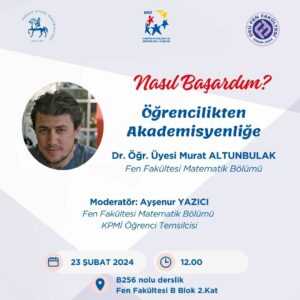M. R. Pournaki, Sharif University of Technology. Date: 29th of March, 2024, Friday, Time: 13.00 – 14.00. Place: Dokuz Eylül Univ., Tınaztepe Campus, Faculty of Science, Department of Mathematics, Classroom B255.
Abstract: One of the fundamental cornerstones of commutative ring theory is the prime avoidance theorem, which states that, if ![]() are prime ideals of
are prime ideals of ![]() and
and ![]() is an ideal of
is an ideal of ![]() such that
such that ![]() , then
, then ![]() for some
for some ![]() . In this talk, we give a proof for the countable version of this theorem due to Sharp and Vamos. The proof uses the celebrated Baire’s category theorem in metric spaces. We then discuss its generalization to the prime submodules.
. In this talk, we give a proof for the countable version of this theorem due to Sharp and Vamos. The proof uses the celebrated Baire’s category theorem in metric spaces. We then discuss its generalization to the prime submodules.
